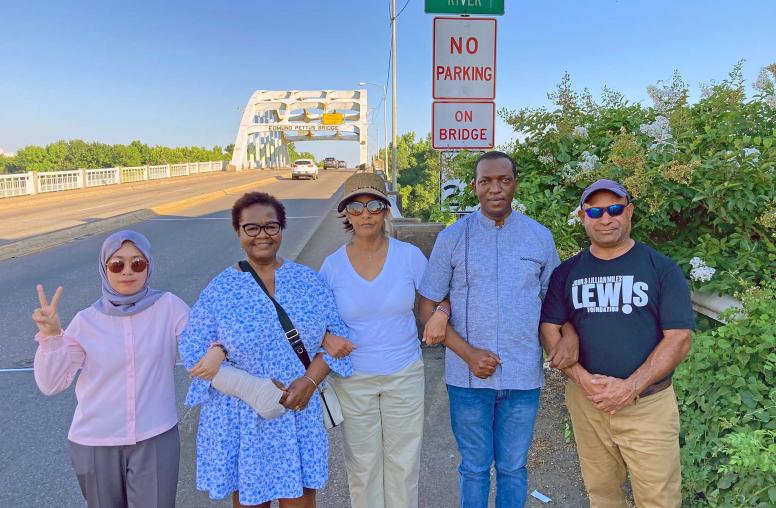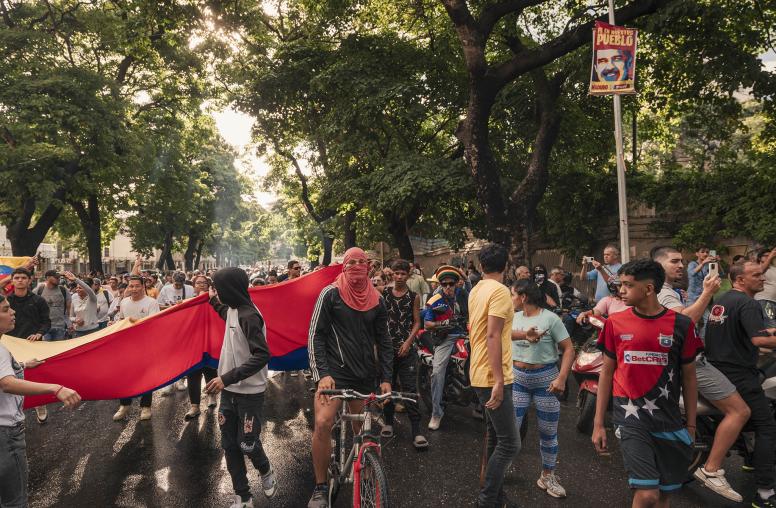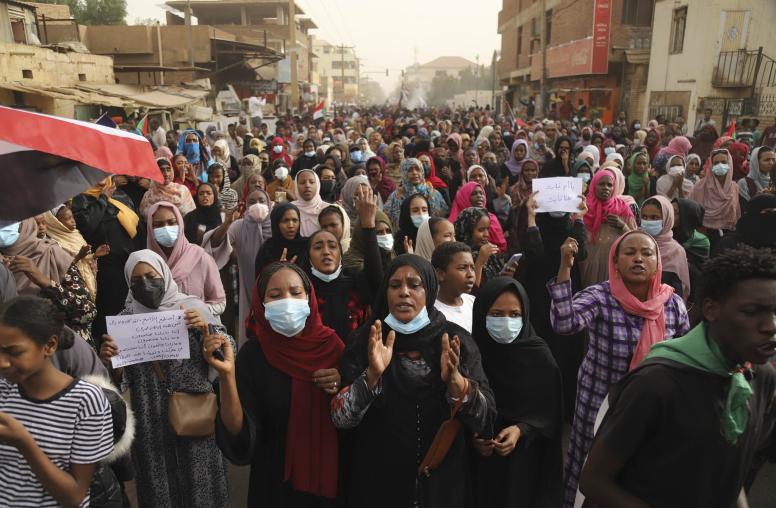Combatting Corruption Amid the Pandemic
As the world responds to COVID-19, the risk of corruption forces social movements to confront old challenges.
As the world deploys unprecedented measures to stem the fallout from the COVID-19 pandemic, the assistance that many struggling people see as a beacon of hope also raises the risk for unchecked corruption. Without a strong counterbalance demanding transparency and accountability, built at the grassroots level, anti-corruption agendas could face a debilitating blow as the pandemic wears on. However, despite the acute vulnerability of the current moment, there is emerging hope that the urgency of the pandemic could also help jumpstart solutions to perennial problems in the anti-corruption space.

“COVID and corruption could potentially offer sort of a convergence,” said Bryan Sims, senior manager of peacebuilding at Humanity United. Speaking at a USIP virtual event honoring International Anti-Corruption Day, Sims went on to say, “I think these issues could bridge the interests of certain people within government and certain folks within movement(s) and civil society to help them organize, but also sort of lay the groundwork for some of the more radical change that needs to happen.”
USIP has conducted a multi-year research project to provide lessons on how policymakers and international actors can best support movements working to advance transparency and accountability. And despite the chaotic nature of the last year, panelists made clear that the initiative’s work can help anti-corruption practitioners chart a course through the pandemic and beyond.
COVID-19 and Corruption
For anti-corruption researchers and activists, the current moment feels like a completely different world than the one they were operating in just months ago. Vital public health measures such as lockdowns have given authoritarians a guise to further consolidate control of public spaces and squash dissent—and COVID-relief funds meant to help vulnerable populations weather the crisis are a ripe target for graft.
Olena Tregub, secretary general of the Independent Defence Anti-Corruption Committee at Transparency International, noted that corrupt actors in Ukraine were already seizing the opportunity to profit. With the attention on the pandemic, Tregub said corruption in other sectors has become less of a priority in Ukrainians’ minds—but that she hopes the International Monetary Fund’s recent audit of a COVID-relief spending program in the country might bring the two concerns together.
Meanwhile, militarized lockdowns and the public health risk of COVID-19 in Zimbabwe and Guatemala have forced anti-corruption movements to quickly change course—often showing extreme resilience in the process. In Zimbabwe, “citizens have been trying to mobilize, trying to come to together to demand accountability around how the COVID-19 funds are being handled” in order to prevent further looting by corrupt actors, said Gladys Kudzaishe Hlatywayo, the secretary for international relations for Zimbabwe’s MDC Alliance.
And in Guatemala, Walter Flores said, “The civil protests by social movements did not stop … we have seen an increased use of digital spaces for protests,” but that people have also returned to the streets after adopting protective measures such as mask wearing and hand washing. The persistence has paid off, as Guatemalans were able to halt parliament’s proposal for next year’s budget that many activists and analysts considered to be corrupt. “People are aware that the pandemic will stay a lot longer, it’s not going to disappear soon, so they are rapidly adapting to the new reality,” said Flores, a principal advisor at the Center for Studies for Equity and Governance in Health Systems.
But despite the pressure and motivation to act immediately, Sims stressed that international donors must take the time to adapt programming based on the assessments of their local partners and the realities they are facing on the ground, which is also a major finding that came out of the USIP research. “As a donor, we need to be really aware of what the environmental costs are of doing this work,” said Sims. “Things like you know, changing timelines and readjusting goals as needed and just trying to be more flexible than what we normally do.”
Broken Promises: Cycles of Corruption
Despite numerous short-term successes, one of the main struggles the panelists found plaguing activists and civil society organizations working to root out corruption is the lack of fundamental reform in the wake of regime change. Without addressing institutional governance, the mechanisms that enabled corruption in the past remain intact.
“We have not seen a transition in Zimbabwe. We have seen a change in leadership,” said Hlatywayo. Despite a rhetorical shift in the wake of the country’s 2017 coup, Hlatywayo noted that the current president, Emmerson Mnangagwa, has “retained and perfected the predatory systems” that helped his predecessor cling to power for decades.
Flores echoed Hlatywayo’s analysis, noting there was a similar experience in Guatemala after an anti-corruption protest movement forced out the country’s president and vice president in 2015: “Despite the energy of mobilization … it all came to a stop once authorities resigned.”
In looking for an answer as to why various movements were being stonewalled just short of widespread reform, Flores and Hlatywayo pointed toward a pattern of broken campaign promises in both countries. “President Mnangagwa promised to put an end to corruption and to bring the perpetrators of corruption to” justice, said Hlatywayo. But once elections were completed, “corruption became so pervasive and has become one of the greatest failures of the current regime.”
Transparency Alone is Not Enough
Even when anti-corruption movements find institutional success, such as in Ukraine, reform alone is often not enough to stem the tide of corruption. “We had a very serious anti-corruption agenda supported by international actors” in post-revolutionary Ukraine, said Tregub. “Yet … corruption remains persistent.”
The issue, Tregub found, was that the institutions were often very transparent, shedding light clearly on abuses of power, but lacked accountability measures to ensure perpetrators were held responsible. She cited a Ukrainian corruption court that prosecuted only six cases in the previous year as an example of this phenomenon.
Flores said he often sees the same mistake made elsewhere: “That’s one of the main weaknesses of many organizations working in the area of good governance and accountability, because they assume that by supporting transparency that situation will automatically lead to” accountability. Both agreed there is a large gap between transparency and accountability, and that uncovering instances of corruption—while vital—is just one part of the equation.
Built for the Long-term: Anti-Corruption Practices That Work
As movements focusing on anti-corruption work begin to find their footing amid the pandemic, many activists and donors are looking for ways to reconfigure their long-term outlook for change.
For Flores, this means drawing inspiration from a long history of anti-corruption work (and success) in Guatemala: “The roots of social movements fighting corruption and impunity have a long history, centuries, particularly in indigenous people.” Pointing to a string of anti-corruption victories leading up to the 2015 ouster of the country’s president and vice president, Flores said the key for future movements will be expanding the fight against corruption to include the judiciary system and the electoral process.
The process will be slow, but Flores made clear that it’s worth it, saying, “it's very difficult to have achievements, or success in accountability, if donors work in a frame of mind of one- or two-year cycles.”
Additionally, Hlatywayo said donor efforts to support sustainable anti-corruption initiatives of civil society and movements will need to be consistent. Funds for democracy and governance in Zimbabwe typically revolve around the election cycle—a trend that Hlatywayo said must change: “It feeds into the propaganda that we get from the government … And Zimbabwe’s sensitives to the role of the West.”
At the heart of an effective strategy going forward will be understanding each individual movement’s ecosystem. “That might mean having a look internally to figure out what types of skills and things that we can offer beyond just funding,” said Sims. “And in situations where maybe we don't have this capacity, looking to other organizations and people who have skills and making sure that we can connect them.” Some of the research initiative’s own findings supported Sims’ analysis, as one of the most effective forms of donor support reported was not necessarily financial—but rather the provision of training and facilitating spaces so that civil society and movement actors could convene on matters of strategy.
This sort of nuance is something all the panelists found necessary going forward, with one consequence of a “one-size-fits-all” approach being the inability of grassroots organizations to get funding from larger organizations. “The majority of support comes from bilateral donors, or large donors using public funding,” said Flores. “They use the same framework that they use to support general development, which is very rigid, logical frameworks … which doesn't really work for this kind of work or support in organic social movements.”


